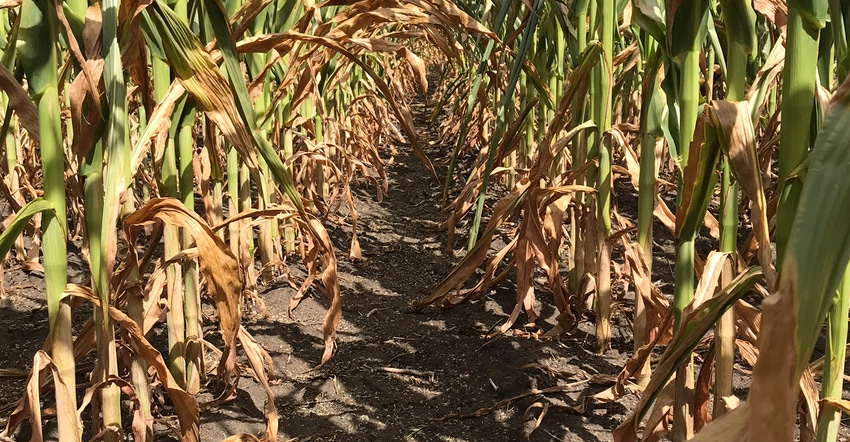July 31, 2020

Lack of rain has teamed up with high temperatures to cause varying levels of drought stress on crops in areas of Iowa this summer. At the end of July, the hardest-hit counties were in western Iowa with drought creeping into central parts of the state. Twenty-three of Iowa’s 99 counties were listed as having severe drought, up from 15 the week before. Areas listed as being in moderate drought or abnormally dry have also grown, according to the July 30 report by USDA’s Midwest Climate Hub at Ames.
There are management strategies crop producers should consider. Iowa State University Extension is holding free weekly webinars for farmers affected by drought. They are archived on the ISU Crops Team YouTube page after each live webinar. Also, check the Iowa State University Integrated Crop Management site at crops.extension.iastate.edu for information. Mark Licht, ISU Extension cropping systems agronomist, offers the following observations.
Higher nighttime temperatures speed up the number of heat units accumulated per day and lead to a faster grain-filling period and earlier maturity. Lack of moisture reduces corn biomass production. This stress can cause delay in silk elongation, interfering with pollination. The result is that poor pollination will occur in dry conditions. If these factors continue through pollination, kernel abortion will occur causing kernels to “tip back” and end up missing at the tip of the ear. Typically, tip-back can occur at the blister stage, but under the most severe conditions, tip-back can occur into the milk stage.
On soybeans, drought conditions can cause plants to stop flowering and even go so far as cause pod abortion. If weather conditions improve, flowering will reinitiate into the early seed filling stage, and pod setting can occur into the midseed filling stage. Hence, rains in August can really benefit soybean yields.
Adjusting yield estimates
Yield estimates on both corn and soybeans are needed to make plans and decisions for harvesting, storage and marketing. Making estimates using the standard formulas is straight-forward.
For corn yield, multiplying number of ears per acre by number of kernel rows per ear by number of kernels per row gives you kernels per acre. Then divide that number by kernels per bushel to get a bushel-per-acre yield estimate. You can go out and do counts in a field to get numbers for the first part of that equation. But estimating the second part — number of kernels per bushel — is difficult.
Normally, the rule of thumb is 90,000 kernels per bushel. But in stressful conditions it will be a higher number. If we get into really stressful conditions, it could be 100,000 to 110,000 kernels per bushel.
It takes more kernels to equal a 56-pound bushel of corn when weight per kernel is reduced by drought. So, using a number from 100,000 to 110,000 kernels per bushel is what you are looking at when trying to make yield estimations in August for drought-stressed cornfields.
For estimating soybean yield, plants per acre times pods per plant times seeds per pod gives you seeds per acre. Dividing that number by seeds per pound in a 60-pound bushel is the estimated bean yield in bushels per acre.
Licht emphasizes it is important to factor in adjustments due to drought. The critical assessment in stress years is to adjust for seed weight. For corn 90,000 kernels per bushel is the typical estimate in non-stress conditions. In stress conditions, this should be adjusted to 105,000 or more kernels per bushel. And 2,600 beans per pounds should be increased to 2,900 or more.
Cover crop considerations
It’s a good idea to plant cover crops following drought-stressed corn or soybeans, Licht says. Cover crops will protect soil and minimize the amount of soil water evaporation that occurs. Cover crops also help absorb accumulated nitrates when rainfall finally comes. To be successful with cover crop establishment in dry conditions, stick with cereal rye. It’s winter-hardy when planted as the cover crop ahead of planting soybeans in spring. Another option is to seed oats as the fall cover, which will winter-kill ahead of planting corn in spring.
The oats approach will limit water use in spring, which could be important if drought conditions continue through winter. Soybeans can withstand dryer conditions than corn, plus beans allow more time for spring termination decisions to be made. For seeding the cover — whether you use aerial, broadcast or drilling — try to plant the cover crop ahead of forecasted rains and use the standard seeding rates.
Plan ahead for harvest
Be aware that drought conditions are conducive for field fires. Make sure equipment is working properly and take precautions to avoid fires. Ensure that your combine settings are adjusted to account for smaller seed size, lighter seed weight, and smaller stem and stalk diameters. Remember, grain lost in the field whether because of loss at the combine head or if it’s spread out the back of the combine can cause problems in the field the following year.
Also, think about postharvest plans. Do you want to try no-till in 2021? Avoiding fall tillage will conserve soil moisture this fall for next growing season. Also, for cover crops to be seeded successfully this fall, pay attention to weather forecasts and try to seed ahead of predictions for good chances of rain.
Resources for additional information include:
ISU Extension’s webinar series addresses key questions regarding drought in Iowa and the impacts on row crops and forages. Viewers will be able to better manage livestock and drought-stressed forages, prepare for use of alternative forages, understand important crop insurance and marketing decisions, and plan for harvest and storage of a drought-stressed crop.
Read more about:
DroughtAbout the Author(s)
You May Also Like






